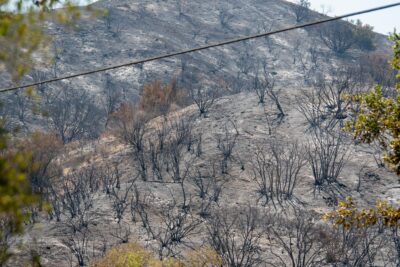All evicted residents have relocated, 1 week ahead of deadline
Los Angeles County officials confirmed Friday that all residents have been transferred from Santa Clarita Hills Senior Living, one week ahead of the eviction deadline the facility gave its senior assisted-living residents.
Nearly all families received a 60-day notice at the beginning of March that the building had been sold. The suddenness of the closure of the 122-bed home prompted an investigation by the county, which worked with the state on oversight, according to officials.
In response to residents’ concerns after the eviction notices, an on-site team from the county also met with the state agency that provides oversight for such facilities, the Department of Social Services, Community Care Licensing, according to a statement from Laura Trejo, the county’s first and current director of the aging and disabilities department, which oversees the Adult Protective Services Program.
She also said the Los Angeles County Long-Term Care Ombudsman Program worked directly with the last few families on rehousing the residents.
However, a 2022 report indicates the concerns are nothing new for a subset of management companies under the umbrella of Pacifica, the nation’s fifth-largest memory care provider, according to a 15th-anniversary news release.
A Pacifica management company ran the Newhall facility until its recently filed bankruptcy, with evidence pointing to dozens of debts and numerous unsecured claims as part of the reason why Pacifica Senior Living Management was seeking Chapter 7 bankruptcy. The report prepared for the Attorney General’s Office on Pacifica facilities in 2022 stated Santa Clarita Hills had a citation rate about seven times the state average.
Representatives from Pacifica have declined to respond to multiple requests for comment on this story, regarding the claims made against it and its proceedings in bankruptcy court. Requests for comments from the staff at the local facility were referred to the corporate office.
L.A. County 5th District Supervisor Kathryn Barger said in an April 11 statement that, while facility oversight was a state issue, the seniors’ situation was a priority for her office, discussing the effort to place the last six residents at that time.
“I appreciate the ongoing monitoring and coordination by our county’s Adult Protective Services team,” she wrote in a statement issued through Helen Chavez, her communications director. “Ensuring the well-being and dignity of every senior during this transition is very important. I will continue advocating for transparency and safe, appropriate placement for all remaining residents.”
Moving on
Pacifica’s Northridge facility, which is also reviewed in an AG report on Pacifica, has a rate exactly on par with the state average for citations, 0.27 citations per 10,000 resident days.
But the Santa Clarita experience has left some wary of the assisted-living care experience.
Sabrina Newton, an SCV resident, said she was upset with Pacifica because her father’s eviction notice was just left on his table in his room for the family to find, days after a meeting with residents.
Part of the challenge for Newton was the closure leaves Santa Clarita with only three other assisted-living facilities to help its seniors: Atria, which is at capacity, and Sunrise, which also filled up quickly after the closure, according to representatives from those facilities. A representative from the third, Santa Clarita Post Acute, was not immediately available.
Cathi Pearson, a Stevenson Ranch resident, also said the lack of nearby places was a real problem, because now she was having to drive to Northridge to see her mother, which makes the more regular trips that both were used to much more difficult.
Neither Newton nor Pearson mentioned the same issues in Northridge that they experienced in the Newhall facility, but they said their frustration was in their dealings with Pacifica.
Pearson said Friday the unresolved issues she has with Santa Clarita Hills appear headed to small-claims court.
She said she missed an initial call from The Signal because she had to spend two hours with the Social Security Administration to get her mother’s official address changed. But that wasn’t close to her biggest hassle from the fallout of the closure.
She was charged thousands of dollars in move-in fees for her mom, who moved into Santa Clarita Hills weeks before the closure was announced, she said.
Considering her response to the question of whether Pacifica gave her any consideration of the transfer to its Northridge facility, she sighed heavily.
“No, Pacifica hasn’t offered me anything. They’re trying to charge me seventeen-hundred-and-some-dollars that they claim that we owe for additional care that my mom got,” she said, adding they told her to expect a bill closer to half of that.
Expert advice
Filings in bankruptcy court list what one observer described as “runaway verdicts” against Pacifica and its 122-unit facility on Lyons Avenue, just off Interstate 5.
In an April 7 filing, attorneys for Pacifica asked for more time to present the meat of its “bare bones” filing to the court regarding the bankruptcy:
“As a result of substantial judgments awarded against debtor, including judgments in excess of $28 million and $6 million, and debtor being named as a party in more than 60 lawsuits nationwide, debtor was forced to shut down its management operation and no longer offers management services,” according to the filing. “Because debtor no longer offers management services, it no longer has a source of income. As a result, debtor filed this Chapter 7 bankruptcy case.”
Steve Moran, an industry observer who runs Senior Living Foresight, a daily blog that provides insights and information about the senior care industry, said from what he could see at Pacifica, each building operates under an LLC, which is contracted to a third-party management company, and pretty much industry standard for operations.
He said in California, efforts to curb bad actors with high verdicts and a lot of regulation have driven up the cost without addressing the problems with bad actors, he said.
“And yet, in California, if you look in the nursing homes in California, what we have is a highly regulated set of really crummy nursing homes, and they just cost a lot more money, and I don’t know that it’s really made them better,” he said.
He didn’t know that more regulation or lawsuits would help, but he did offer advice on how to inspect a facility.
In terms of the Pacifica situation, he hadn’t drilled down into the specifics of its problems, but he mentioned the AG’s report and said any time you have higher than average citation rates, it’s a concern.
He also recommended a “drop-in” type of visit at an assisted living facility versus a scheduled appointment interview, which might provide a more earnest view. Making an appointment in the evening also might help.
Checking review websites for any recent red flags, as well as how they respond can give an idea of how they help. He said looking at the employee reviews from Glassdoor and Indeed can provide insight about the atmosphere.
Myles McNamara, president/owner of Comfort Keepers, said doing “your due diligence” in that respect is critical, suggesting that people can also look at a facility’s licensing status to see if there are any problems.
He cautioned about the business reviews, because sometimes there can be unreasonable complaints. Looking at the volume of lawsuits can also be an indicator within reason, he said, when asked about the dozens facing Pacifica.
“Well, that’s just it, if they’ve got one slip and fall, in two and a half or three years — seniors fall,” McNamara said, “but if they’ve got 92 in three years, then something is going on.”
Lawsuits, past concerns
While observers suggested the lawsuits are tied to the closure of Santa Clarita Hills, L.A. Superior Court and federal bankruptcy court records indicate Newhall was not its biggest liability at the time of its closure.
“For 21 of 32 Pacifica facilities (66%), the rate of total citations … is higher than the California average,” according to the AG’s report. At the Lyons Avenue location, the citation rate was 1.54 per 10,000 resident days, versus the state average of 0.27, per the 2022 AG report.
On Friday, the online docket report for Pacifica’s proceedings in the U.S. Bankruptcy Court for the Southern District of California in San Diego, where the business is based, indicated the “debtor has not timely provided the required income tax return to the trustee within seven (7) days before the date first set for the first meeting of creditors,” and that “failure to comply with the above requirement may result in dismissal without further notice.”
However earlier in the week, attorneys for Pacifica Senior Living Management LLC, which operated the Newhall facility, reported $859,976.57 in personal property and $37,160,340.57 in liability.
The bulk of that, $28 million, came from a lawsuit against a Bakersfield facility, which the state’s 5th Appellate district upheld in September 2024.
“After a multiweek trial, the jury awarded $149,000 in economic damages, $8 million in noneconomic damages, and $15 million in punitive damage,” according to the appellate court’s ruling in favor of the surviving family of an 81-year-old man who died there.
Another lawsuit cited the company’s past communications strategy as a major financial liability.
The company was hit with a $6.3 million verdict — for 42 violations at the maximum allowable penalty, $150,000 per violation — for using an architectural photographer’s images repeatedly without permission. The judgment was described as the largest ever in an architectural trade publication.
Also listed among the unsecured claims are hundreds of thousands of dollars in legal bills and more than $1.8 million in lab services related to its court cases








